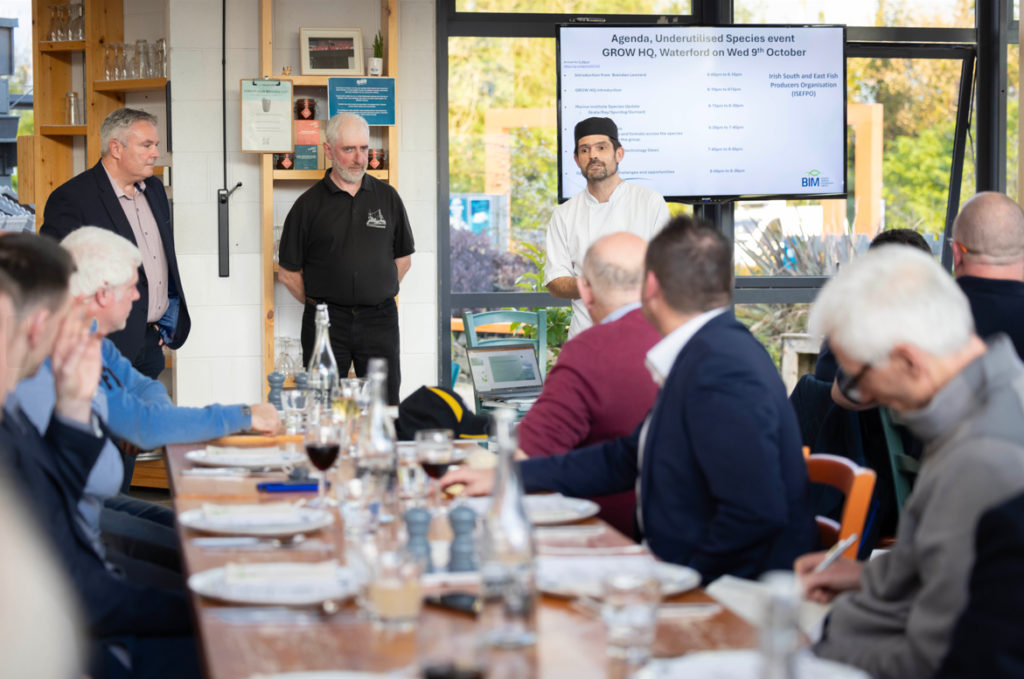
JB Dubois, Chef and Head of Food, Grow HQ, preparing dishes using Red Gurnard, Skate and Rock Salmon.
Members of Ireland’s fishing sector, seafood processors and retailers gathered in Waterford this month at an event showcasing the potential of Ray, Rock Salmon and Red Gurnard. BIM and the Irish South and East Fish Producer’s Organisation hosted the industry event at Grow HQ, an organic café in Waterford city pioneering a sustainable food system, with much of the food it serves grown on site.
Richard Donnelly, Development and Innovation Director, BIM referred to the challenges of introducing new species to market and of the benefits to be gained from casting a wider net and expanding the repertoire of seafood processed in Ireland.
“The seafood supply chain breeds on consistency. Buyers expect products to be of a consistent supply and quality. Adding new species into the mix disrupts the ‘every second counts’ systems in place, especially for a highly perishable food like seafood.” Donnelly added. “However, the demand for high quality sustainable seafood is a constant and the market welcomes disruption, particularly when it comes to new produce and new flavours.”
Brendan Leonard, fisherman and vessel owner, MFV Caronia II and Irish South and East Fish Producer’s Organisation Director welcomed the event describing it as a “first step in the journey”.
“You could sense the interest among everyone attending tonight’s event was genuine. These are stunning fish, there’s no doubt about it. Processors are always looking for new product; we have quota and fishermen can catch it. These would work as products. However, the reality is we’ve lost the market place for these species and the skillset to know how to process them. A re-education needs to happen. These are labour intensive species to process. For example, while technologies exist to skin Rock Salmon, there’s no machine that can filet it yet in place,” said Leonard.
A father of four, Brendan Leonard, spoke about the potential of introducing these species to market for use in products such as fish cakes and fish pies to begin with, stating: “For one, I’m certain my children would demolish a fish pie made with any of these fish. However, there’s a lot of work to be done to re-educate people of their potential. Right now there’s lots of questions. We’re trying to figure out the best route to follow. This is a work in progress.” Leonard added. “30 years ago, we exported all our hake and now it’s the ‘new cod’. We barely export any. This is linked to more people holidaying overseas, coming home with new tastes and of course, it’s down to strong marketing too.”
Grow HQ chef, JB Dubois created a sample of dishes for industry attending the event including fish cakes made with rock salmon, cured gurnard gravadlax, ray bouillabaisse, pan roast gurnard tandoori and fish pie made with ray.
Brian McCullagh, Managing Director, Morgan’s Fine Fish, described the event as “exceptional with an impressive array of dishes prepared on the night, showing the potential for these proteins”. He said that he has agreed to trial new skinning technology for Rock Salmon, “to see how it works, how it performs.” He added that with “contracting quotas in other species, it’s vital to explore these lesser used ones” emphasising that “strong agency-wide support was needed by industry to understand market opportunities here and in markets such as France and Spain where ongoing ‘cost of living’ crisis may open doors to lower cost animal proteins such as these.”
The event included presentations by the Marine Institute outlining the most recent scientific assessments of the species. Fish processing technology maker, Steen also gave a short talk on processing technologies and equipment for these species.
Richard Donnelly said that challenges remain around the ability to process these fish to scale and that work in this space is continuing. He added.
“Having so many engaged stakeholders in one room has given rise to new conversations and sharing of ideas. This collaborative approach is the key ingredient to further explore processing capacity and market opportunities.”

